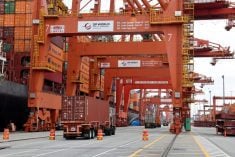KISSIMMEE, Fla. — The United Soybean Board is throwing its considerable weight behind high oleic soybeans in an effort to regain market share lost to canola and other crops.
USB is partnering with DuPont Pioneer and Monsanto, two companies with high oleic soybean varieties on the market, to boost the profile of the new trait amongst farmers and food companies.
The partnership is intended to accelerate market development of high oleic soybeans in an effort to recapture market share lost to canola, palm and sunflower oil.
Read Also

Canadian trade data delayed by U.S. government shutdown
Canadian international trade data for September will be delayed indefinitely due to the ongoing partial shutdown of the United States government, Statistics Canada said Friday, Oct. 24.
The USB estimates it has lost 28 percent of the U.S. edible oil market to the competing crops. It has lost about four billion pounds of soy oil demand each year since 2008.
The program will promote the benefits of high oleic soy to farmers. It will ensure high oleic soybean oil is made available to food manufacturers and food service companies for performance and product formulation tests.
The administrators of the U.S. soybean checkoff will also be partnering with chefs, creating recipes and holding cooking demonstrations to promote the oil.
USB expects high oleic soybeans to add eight billion pounds of annual demand for U.S. soybeans, which would require 718 million bushels of production.
Jim Call, vice-chair of USB, said the new trait will comprise an estimated 30 percent of U.S. soybean acres in 10 years.
“For me it’s the most exciting thing since the Roundup technology came out,” said the soybean farmer from Madison, Minnesota.
“It’s all about getting our market share back and keeping the value of our soybean oil where it should be.”
Full commercial launch of the product in the United States has been held up by the lack of global approval of the trait. Developers of the crop are still awaiting approval from China and the European Union. Those are expected soon.
Growers planted fewer than 500,000 acres of the genetically modified crop last year. Elevators and crushers are taking steps to keep the unapproved trait out of seed and oil exports.
The trait is being commercialized first in Indiana and Ohio by growers in close proximity to crushing facilities in those states.















